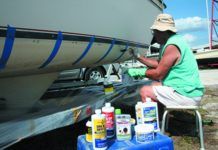Balsa vs. Foam Cores
OK, I admit-I am cheating a bit. While my first love is sailing and I am the proud owner of a 24-year-old J/24, I also have a power boat, a Boca Grand 26, which is no longer manufactured. The hull is solid fiberglass and the topsides and deck are cored with Divinycell. My question pertains to both power and sail:
I am well-versed in the plusses and minuses of end-grain balsa, but I know practically nothing about closed-cell cores like Divinycell and Klegecell. On the surface, at least, it would appear the synthetic coring is far superior if it doesn’t rot or allow lateral water flow. However, the long-time do-it-yourselfer in me tells me it can’t be that simple or all boats would be cored with the stuff. So, can you tell what the downside is to this stuff so I can protect my investment?
By the way, the Boca Grand is a great boat. It’s tough and handles the Chesapeake Bay chop very well with a minimum of pounding. Could it be the problem is weight? Thanks for any help you can provide.
-Norman Smith
Richmond, VA
Rick Strand of Strand Technologies, author of our recent article on blistering (July 15) provides this answer:
I was probably at TPI (Tillotson-Pearson) when your J/24 was built. TPI is one of the few builders that truly knows how to use balsa well. Every hull was tap-tested to make sure that every four square inches of wood was firmly in contact with the outer skin before the inner skin was built. If not, the unbonded core was removed and replaced properly. TPI also hot-coats the grain ends with resin to seal the grain against water permeation. Submerged laminates built in this fashion will not wick water in a direction perpendicular to the grain. This also helps to prevent rot from occurring.
If these simple steps are not part of normal production, that is where balsa gets its bad reputation with respect to moisture. Balsa has higher shear strength, puncture resistance, and fatigue resistance than foams of similar density.
Both Klegecell and Divinycell are PVC foam cores that are cross-linked. Their molecular structure looks like fishing net in three dimensions.
There is a third major PVC core brand called Airex, which is also PVC but not cross-linked. The Airex material will resist fatigue and impact better than the cross-linked materials, but has a tendency to creep under sustained loads like those imposed by poppets, etc.
The foams with thin-skinned composites cannot support a sharp (puncturing) impact. Your J/24 would probably have been holed by now if it had a PVC core and laminate skin thicknesses that are typical of a J/24.
The foams will not rot or readily absorb moisture. With respect to your powerboat, you have a good compromise construction. A solid bottom has fewer concerns where impact, puncture, and moisture absorption are concerned. Above the waterline, the foam construction will be lighter than the balsa. It is probably a bit less expensive to produce and has fewer moisture concerns as well.
Bottom line: there arent too many downsides to foam. Application is everything.
More information can be obtained from the core manufacturers or from texts like the Handbook of Composites by Peters.
———-
Another Mast Corrosion Fix
My aluminum mast sat within a stainless steel socket. Severe corrosion required cutting about 2 inches from my mast butt. (See PS Advisor, August 1.) As my halyards were internal, a severe shortening of the mast would have interfered with the halyards leaving the mast.
Swenson’s Marine in Alameda, CA solved the problem by shortening the mast about 3 inches and building a phenolic plug which fit exactly into the stainless mast base. Slightly abovethe top of the stainless mast base the plug has a shoulder, and above this shoulder the plug was fitted tightly up into the base of the mast by a few inches. The plug shoulder, upon which the mast sat, was adjusted so its height compensated for the aluminum removed from the base of the mast. The fix was made in 1989 and my mast continues to give excellent service. They saved me from the expense of anew mast.
-Chuck Soules
Alameda, CA





































